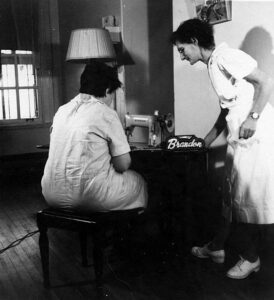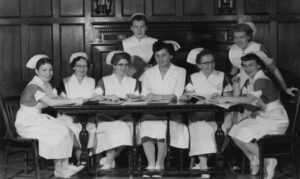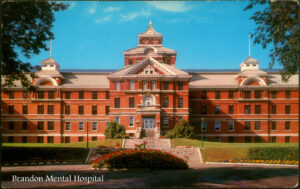Brandon
Names of Institution:
Brandon Asylum (1891)
Brandon Insane Hospital (1912)
Brandon Hospital for Mental Diseases (1919)
Brandon Mental Health Centre (1972)
Opened:
1891 – closed 1999
Location:
Brandon, Manitoba
The mental hospital was situated on the north slope of the Assiniboine River, across the river from and about a mile and a half north of the city of Brandon.
Period of Deinstitutionalization:
Early 1960s to mid-1980s
Patient Demographic:
The in-patient population peaked in 1955 at 1,689 persons. While the population remained greater than 1,600 for the balance of the decade, it declined almost every year thereafter.
In the 1960s, the trend toward shorter in-patient stays meant that, while more patients were admitted than ever before, daily in-patient numbers continued to decline. By 1970, about 750 in-patients remained, approximately 300 of whom were chronic schizophrenics and many of whom were deteriorated and aged, were receiving custodial care, and were not considered at the time to be candidates for discharge.
Deinstitutionalization:
While in-patient population steadily declined throughout the 1960s, de-institutionalization began in earnest in the 1970s. In 1971, the recently elected NDP government hired Graham Clarkson, architect of the reorganization of Saskatchewan’s Mental Health Services in the 1960s, to develop a master plan for restructuring Manitoba’s mental health system. Clarkson’s report, released two years later, called for a fundamental overhaul informed by three principles: normalization, care in the community, and regionalization of services. Clarkson was notably concerned with the hierarchical nature of the provincial mental hospitals and, subsequent to his report, the office of the Medical Superintendent was abolished and replaced with a Clinical Director and a Lay Administrator, and the entire hospital was reorganized into interdisciplinary teams.
In 1974, Minister of Health and Social Development Saul Miller committed to de-institutionalization and to the integration of mental health, social development, and antipoverty strategies as the key goals of his department. Miller set a target of reducing, by 1979, the province’s total in-patient population by 40 percent to 600.
In 1975, the government published a white paper, Mental Health Programs in Manitoba, that affirmed many principles of the Clarkson Report. The report outlined the government’s intention to put 200 “community mental health workers” (psychiatric nurses, social workers, and psychiatrists) in the field and to establish fifty new community residences housing no more than ten people each.
Recognizing the burden that this program would place on the institutions, the government planned no immediate reduction in the staff complement or in resources allocated to the mental hospitals. Two years later, the incoming Conservative government reversed this promise, making deep cuts to in-patient services and provoking accusations of “dumping.”
Medication became a key technology for deinstitutionalization. In 1965, the Brandon Mental Health Centre (BMHC) introduced Moditen, a slow-acting, injectable psychotropic drug administered on a fourteen-day cycle. This innovation allowed for supervised drug therapy in noninstitutional settings and, most especially, facilitated the discharge of patients back into rural communities, where they received their biweekly injections in their homes from Community Psychiatric Nurses. A Moditen clinic was also established at the ARM Industries Sheltered Workshop in Brandon.
In 1969, the hospital opened its first predischarge ward for long-stay female patients. Ward patients were responsible for their own personal grooming, for maintaining their clothing, for keeping the ward clean, and for preparing breakfasts and lunches. Programs which included frequent trips to town to attend cultural events or simply to go to the shopping mall were arranged to familiarize patients with tasks like riding the bus, negotiating traffic lights and street signs, and using money. Similarly, trips to restaurants and ward events like formal teas helped to revive social graces in long-stay patients and reacquaint them with rituals that they had long since forgotten.
In 1976, the Functional Living and Self Help (FLASH) program was created to teach basic living skills to long-stay female patients. The goal was to correct deficiencies in living skills such as personal hygiene, cooking, time and money management, housekeeping, use of public transportation, and basic social skills. FLASH participants were instructed in a classroom specially constructed for their needs, and they practiced their skills on outings to movie houses and restaurants.
Parkland Villa was established in 1978. It was a six-bed housekeeping unit in a former physician’s cottage where male patients could live semi-independently prior to discharge. A second house was opened in 1981.
In 1978, the hospital hired a Certified Life Skills Coach to provide counseling and support in five areas: Self, Family, Job, Community, and Leisure. Both in-patients and outpatients used the Life Skills program.
The return of the NDP in 1981 brought with it a renewed commitment to community mental health. A decade after the Clarkson Report, a 1983 report by Health Department planner David Pascoe set down a new road map for de-institutionalization and community care. Pascoe called on the province to close altogether the Brandon and Selkirk facilities by 1990 and to replace them with a series of small regional psychiatric centres and personal care homes. Although the report was officially rejected by the government, who sensed a strong public attachment to custodial care and public concern over job losses in Brandon and Selkirk, it nonetheless substantially informed provincial approaches to mental health care.
Trans-institutionalization:
In 1962, the Brandon Branch of the Canadian Mental Health Association (CMHA) hired a volunteer coordinator to facilitate hospital visiting and to operate the city’s first Open Door Club, which provided work-related psychosocial rehabilitation. The Open Door Club operated until 1979, when it was closed due to cuts in government funding.
In 1964, the hospital identified that two-thirds of all its in-patients represented a “hard core” of thoroughly institutionalized persons who received little or no therapeutic care, and half of the people in this group were over the age of sixty-five. A target was set to remove them to nursing homes by the end of the decade.
In 1964, a foster home program was established for patients with funding from the Provincial Welfare Department, the Dominion Veterans Association, and several municipalities. By the mid-1970s, there were approximately 250 outpatients living in forty farm homes, twenty-five boarding houses, and twenty-five foster homes. Three years later, the BMHC purchased its first group home, or “halfway house,” which operated in partnership with Alcoholics Anonymous.
By the mid-1970s, it was apparent that the foster placement program was on the verge of collapse. By the late 1970s, with the foster care system wide open to the exploitation and abuse of ex-patients and most foster-home operators feeling undercompensated and burnt out, new strategy shifted to focus on group homes. In 1978, the BMHC took over a five-bedroom duplex in downtown Brandon and opened McTavish Manor, the first provincial group home for transitional patients. As mentioned above, that same year, Parkland Villa was established on the hospital site; it was a six-bed housekeeping unit where male patients could live semi-independently prior to discharge. A second house was opened in 1981.
In 1983, Community Welcome Co-op was established as a co-operative venture between the BMHC and the Westman CMHA to replace a now-defunct Open Doors Club. Located in a large heritage home in Brandon East, the Co-op provided a range of housing, employment, and recreational services.
In 1985, the Salvation Army (SA) established Dinsdale House in downtown Brandon. In addition to sixty personal care-home beds operated by the SA, the facility also housed thirty provincially funded pychogeriatric beds and an adult day program run by the BMHC.
In 1986, BMHC rented a large house in Brandon and renovated it into a six-bed in-patient group home. These beds were reserved for patients who were not considered candidates for discharge. The first six patients to be transferred to this facility had been in-patients for an average of thirty-five years. Contrary to initial expectations, all six were discharged within two years.
In 1988, patients from the former psychogeriatric unit at BMHC now numbered just over one hundred. They were moved to Rideau Park Lodge, a nursing home in Brandon. With the completion of this move, two of the four main buildings at the hospital site stood empty of patients.
Work Therapy into Occupational Therapy:

Occupational Therapy at BMHC expanded significantly in the 1950s, reflecting a growing commitment to preparing patients for community living. In 1957, a Special Placement Officer from the Unemployment Insurance Commission was assigned to visit the hospital on a monthly basis, meeting soon-to-be-discharged patients to help them find suitable employment.
In the 1950s, the hospital established a beauty parlour to provide hairdressing services for the female patients. One of the chief goals of this project, which was funded through the Mental Health Grants Program, was to supply female patients with vocational skills that could be a means of subsistence for them upon discharge.
In 1960, Occupational Therapy (OT) was offered for the first time on the male wards, but only in winter when there was a lack of farm work. Activities included crafts and industrial work disassembling and recycling electrical apparatuses and winding motors. OT for male patients remained very limited through the 1960s. In 1962, the Brandon CMHA established an Industrial Therapy Committee. In addition to operating three canteens, the CMHA established a scrap metal business, a book bindery, a paper-folding/envelope-stuffing business, and a retail store that sold these items to the public.

By the mid-1960s, the use of patient labour on the farm—a long tradition at BMHC—was in decline. This was a result of mechanization (the last horses were sold in 1965), a more frail and/or elderly patient population, and a trend away from industrial therapy and toward occupational therapy. The farm was eventually closed in 1971 without much controversy or debate.
Modernization of other hospital services reduced the amount of work available to (or required of) patients. Major kitchen renovations in 1967 eliminated patient jobs in food preparation and delivery, and an automated central dishwashing plant ended the practice of dishwashing by hand on the wards. The gradual closure of the farm in the latter half of the 1960s eliminated even more jobs in canning, pickling, and preserving, as well as in butchering and plucking. Similarly, in 1968, the major renovation of the laundry facilities and the reorganization of the Housekeeping Department saw patient labour being substituted by machine labour and ward cleaning being made the responsibility of paid janitors and housekeepers.
Patient into Person:
In 1955, the hospital saw the complete abolition of mechanical restraint, although this was seen at the time as a reflection of finally attaining an adequate staffing complement rather than as a question of patient rights. In 1957, three female patients were set up to live in a former physician’s apartment in the BMHC with their own keys. Although this appears to have been a one-time experiment, it was a successful one. By the end of 1958, nine wards representing about 50 percent of the hospital’s population were unlocked, and over thirty chronic patients were issued “leave passes” that allowed them to go home for up to thirty days. Over 50 percent of the patients in the acute in-patient facility (the Receiving Unit) were sent home for Christmas that year.
In 1962, the male nursing section adopted a program statement: “To modify our thinking in respect to areas in which our male patients live, work, and play. To improve our ward surroundings to provide a more home-type atmosphere. Also to rehabilitate our patients to function in the hospital as one would expect in society …”
Beginning in 1965, the male and female sides of the hospital were no longer administratively separate. For the first time (with the exception of physicians), male staff worked with female patients. Different wards serving similar patient groups were put under unified administration with a unified staff, which facilitated interaction between male and female patients.
The Industrial Therapy Program, which was operated by the CMHA as a number of independent businesses, sought to “maintain or restore proper working habits” and emphasized “regular attendance, punctuality, acceptance of work assignments, good work quality, completeness of work, [and] proper social contact with co-workers and staff.”
In 1967, the disused tuberculosis ward was converted into a behavioural therapy unit. While behaviour modification, including aversion therapy, became a key treatment modality for what were seen to be serious disorders (from alcoholism to homosexuality), operant conditioning was also widely deployed as a way of reinforcing social skills in chronic patients with an eye to preparing them for eventual discharge. In addition to intensive work with individual patients, the behavioural therapy staff trained ward staff in the use, on the wards, of conditioning techniques and token economies to reinforce comportment, table manners, etc. After 1971, on wards with high-functioning patients, patient councils were elected. This approach was largely supplanted by the FLASH program (mentioned above) in 1976.
In 1973, the first patient was employed as a ward aide in the geriatric hospital. She was placed on regular shift rotation and given regular assignments (although it is not clear how she was paid). The 1975 white paper cited above called for the creation of “personal development programs” for each user of mental health services. These individualized programs were intended to impart vocational and social skills for independent living.
In 1975, the hospital opened Holiday House in Russell. While its primary function was to provide respite for foster families who wanted to take summer vacations, the house also offered holiday breaks and a change of routine for outpatients In the early 1980s, the hospital sold the house in Russell and replaced it with a pair of summer cottages on Pelican Lake near Ninette.
Throughout the 1960s and 1970s, in-patients and some outpatients went to summer camp; the hospital rented from the Anglican Church a summer camp at Clear Lake for two weeks every August. By the early 1980s, too few of the remaining patients were young and fit enough to attend the camp, and the program was discontinued.
While patients had long been offered small wages for their work, beginning in 1970, long-term patients were supplied with spending money. The amount they received was tied to their conduct and to the work they performed in Industrial and Occupational Therapy or on the wards and in the CMHA canteens.
In 1976, wards were integrated for the first time to provide opportunities for more normal interactions between male and female patients. Integration meant the end of separate day rooms and dining rooms for men and women. In 1976, the psychogeriatric colony (Norwood Gardens, located about a mile from the main hospital) secured a wine and beer license and started to offer weekly “pubs.”
Staffing in the Deinstitutionalization Era:

In 1921, the Brandon Hospital for Mental Diseases became the first site in western Canada to train mental nurses and continued to offer some form of a training school until the program was moved to Brandon University in 1995. Training that led to a diploma was initially available only to women, with only noncompulsory and inferior training provided to male attendants until 1947, when gender equity was achieved. The dramatic expansion of the training program after 1947 was critical in supplying the BMHC with the stable cohort of trained staff necessary to modernize patient care and finally help reverse the pattern of relentless in-patient population growth by midcentury. In 1960, the Province of Manitoba joined Saskatchewan, British Columbia, and Alberta in recognizing the Registered Psychiatric Nurse as a professional and occupational category.
The employment of a large number of ward aides similarly contributed to the depopulation effort. The first nine auxiliary nurses were hired in 1956. By the mid-1960s, the number had increased to around one hundred and, in 1970, the hospital elevated the training requirement for nursing assistants with the introduction of a compulsory certificate program.

In 1971, BMHC staff were given the option of wearing either uniforms or their own clothes. A 1976 survey of staff and patients found both parties coming out heavily in favour not only of uniforms, but also of uniforms that more clearly indicated the hospital hierarchy. In the end, very few nurses took up the option to wear non-uniform clothes, citing as reasons both cost and role clarity; a majority of ward nurses wore uniforms into the 1980s. Nurses in community roles and senior administration rapidly switched to non-uniform clothes.
Prior to the 1960s, there was very little integration of male and female services, and male and female wards used different key systems. This meant that male staff could not use their keys to enter female wards and vice versa, even in the event of an emergency. In 1970, the male and female nursing services were unified into a single service.
De-institutionalization broadened the professional possibilities in psychiatric nursing. In 1973, the Government of Manitoba selected six Registered Psychiatric Nurses to receive special training in community service delivery. A year later, these six would become Manitoba’s first cohort of Community Psychiatric Nurses (CPNs). Seven more were trained in 1974, and a six-month postgraduate program was inaugurated. Deployed in the communities of Brandon, Virden, Hamiota, Melita, and Reston, the CPNs facilitated more than 1,000 admissions to general hospitals and 209 placements of hospital patients in foster homes, group homes, or nursing homes in 1974 alone.
In 1973, the first off-campus outpatient clinic was established out of the Public Health Nurses’ Offices in downtown Brandon.
Sources:
Brandon Hospital for Mental Diseases. Annual Reports of the Brandon Hospital for Mental Disesases. Winnipeg: Manitoba Department of Health and Social Development, 1972.
Clarkson, J. Graham and M.D.T. Associates. Mental Health and Retardation Services in Manitoba. Winnipeg: Manitoba Department of Health and Social Development, 1972.
Dooley, Chris. “When Love and Skill Work Together: Gender, Work Skill and the Occupational Culture of Mental Nurses at the Brandon Hospital for Mental Diseases.” MA thesis, University of Manitoba, 1998.
Dooley, Chris. “‘The older staff, myself included, we were pretty institutionalized ourselves’: Authority and Insight in Practitioner Narratives of Psychiatric Deinstitutionalization in Prairie Canada.” Canadian Bulletin of Mental History 29:1 (2012): 101–123.
Dooley, Chris. “‘They Gave Their Care, But We Gave Loving Care’: Defining and Defending Boundaries of Skill and Craft in the Nursing Service of a Manitoba Mental Hospital during the Great Depression.” Canadian Bulletin of Medical History 21:2 (2004): 229–251.
Hicks, Beverley. “From Barnyards to Bedsides to Books and Beyond: The Evolution and Professionalization of Registered Psychiatric Nursing in Manitoba, 1955–1980.” PhD thesis, University of Manitoba, 2008.
Manitoba Department of Health and Social Development. Mental Health Programs in Manitoba. Winnipeg: Department of Health and Social Development, 1975.
Miller, Saul. Keynote address at The Mental Health Association AGM, 1974.
Pascoe, David. Mental Health Services in Manitoba: A Review and Recommendations. Winnipeg: Manitoba Department of Health, 1983.
Provincial Archives of Manitoba, GR 6224. Assorted files. Brandon Mental Health Centre Fonds.
Refvik, Kurt. A Centennial History of the Brandon Asylum, Brandon Hospital for Mental Diseases, Brandon Mental Health Centre. Brandon: BMHC Historical Museum Inc., 1991.
Tipliski, Veryl. “Parting at the Crossroads: The Development of Education for Psychiatric Nursing in Three Canadian Provinces, 1909–1955.” PhD thesis, University of Manitoba, 2002.


